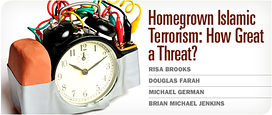Risa Brooks expresses skepticism regarding radicalization theories that propose a direct or inevitable progression from fundamentalist ideas to violent action. She is entirely justified; empirical studies of terrorists have long found there is no such identifiable pathway, pattern or profile. Yet, as a continuing series of hearings held by Rep. Peter King illustrate, the idea that entire communities should be treated as suspect because of the bad actions of a few is hard to defuse.
This is particularly true with terrorism, which is distinguished from more typical violent crime by its political motivations. Because terrorism is inherently political, the response to terrorism is often political as well. The most obvious manifestation of this phenomenon is the attempt to brand all who share the terrorist groups’ identifying characteristics or ideologies as “fellow travelers” who secretly support the violence, as a way to discredit them or the influence of their ideas. This tactic is not new.
One of the earliest official studies of “radicalization” was initiated in 1919 by the New York State Legislature, in response to a wave of anarchist violence. Using innuendo and a guilt-by-association approach, the Joint Committee to Investigate Seditious Activities, known as the “Lusk Committee” after its Chairman, Senator Clayton Lusk, published a 4,000 page report called “Revolutionary Radicalism: Its History, Purpose and Tactics,” that smeared pacifists, teachers, journalists, trade unions, socialists, and civil rights groups as co-conspirators in an international communist campaign to destroy the American way of life. One of its targets was the National Civil Liberties Bureau—forerunner to the American Civil Liberties Union—which it accused of such nefarious deeds as providing lawyers to people charged with seditious activities or refusing military service. Not surprisingly, the Lusk Committee was unsuccessful in finding real threats and its efforts, which included expelling duly elected Socialist Party members from the legislature, were ultimately denounced as “unsound and vicious” assaults on free speech, thought, and association.
Echoes of the Lusk Committee can be heard in the King hearings, and in the biased and factually flawed anti-Muslim training materials produced by the FBI, Homeland Security, and Defense Departments, as well as a host of private actors, that have undoubtedly influenced a generation of federal, state, and local law enforcement and intelligence agents. Once again, law enforcement is targeting and mapping entire communities based on their race, religion, and ethnicity, just as the Lusk Committee did.
And it shouldn’t surprise anyone that civil rights groups are again being singled out for scorn and derision. But modern officials have a tool the Lusk Committee never dreamed of—over-broad material support for terrorism prohibitions that criminalize even “seemingly benign” association with banned groups, such as teaching non-violent dispute resolution, negotiating to enable humanitarian aid efforts in conflict zones, or even speech advocating non-violence. This is the statute Douglas Farah references in his discussion of the Holy Land Foundation case, yet its existence (and the government’s often controversial use of it—see here and here) undermines the rest of his argument. The law today gives the government almost unfettered authority to designate individuals and entities as Foreign Terrorist Organizations, and to seize the assets of groups it says materially support terrorism. So if the government had reliable evidence that groups Farah singles out, such as the Council on American Islamic Relations, the Islamic Society of North America, and the Muslim American Society actually support terrorism, it has a formidable arsenal of legal weapons available to shut them down and prosecute them. The fact that it hasn’t speaks volumes.
The Lusk Committee’s pursuit of organizations based on their support for liberal causes distracted the government from investigations of real threats and challenged our country’s commitment to our constitutional values. We should learn from this history rather than repeat it.

